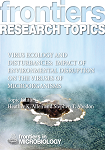
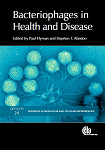
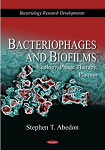
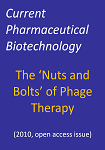
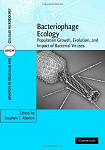
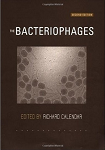
∞ generated and posted on 2017.03.08 ∞
Discussion of killing titers and their utility especially to phage therapy.
Please cite as:
Stephen T. Abedon
Expected Efficacy:
Applying Killing Titer Estimations to Phage Therapy Experiments.
killingtiter.phage-therapy.org
| A Killing Titer literally is a phage titer estimation that is based on the ability of phages to directly kill bacteria. This is versus, for example, the potential for phages to be visualized as plaques. It is based on a Poissonal comparison of bacterial viable counts, post-phage to pre-phage application. The essay consists of Abstract, Introduction, discussion of Killing Titers, discussion of Application, a discussion Multiplicity of Adsorption, a discussion of Predictions of Experiment Efficacy, and References, the latter with links to online resources. For discussion of phage adsorption theory, see adsorption.phage.org. For a multiplicity of infection calculator, see adsorption.phage.org. |
Abstract
Scientific experiments ideally will be hypothesis driven, will have some expectation, a subsequent observation, and then some potential for comparison between these two. If observations and expectations do not coincide, then we reject or reformulate the hypothesis, or instead question the experiment itself. In many cases it is helpful for both expectations and observations to be quantitative, with an observation agreeing with an expectation as seen, for example, as conversion on a single number. Given how basic these concepts are, it can be surprising when a simple method exists towards which experimental expectations can be easily calculated, but which nevertheless does not appear to be generally used. Here I discuss the calculation for killing titers in phage therapy experiments. I consider what information may be gleaned from killing titers in terms of phage therapy pharmacology as killing titer determinations can be used to easily distinguish active treatments from passive ones, or either from otherwise inadequate treatments.
Introduction
Phage therapy, or more generally phage-mediated biological control of bacteria, is the use of bacterial viruses to reduce numbers of pathogenic or at least nuisance bacteria (Abedon, 2009 ; Abedon et al., 2011 ). The technique is based on the idea that the adsorption of a lytic phage to a bacterium will result in the death of that bacterium. These phages are considered to display single-hit killing kinetics (Bull and Regoes, 2006 ) such that bactericidal interactions are discrete, that is, rather than consisting of the interaction of hundreds or thousands of individual antibacterial units with a target bacterium to effect antibacterial activity.
Given more or less equivalent properties for target bacteria within a population, and also equivalent properties for applied phages, then the consequence of phages interacting as discrete entities with bacteria is that those adsorptions can be modeled statistically as a Poison distribution (Dulbecco, 1949 ). With a Poisson distribution we can readily predict that fraction of bacteria which will have adsorbed no phages, that fraction which will have been adsorbed by a single phage, that fraction that will have been adsorbed by 2 phages, and so on. Here we are concerned solely with the no-phage-adsorption category, which is predicated to be equal e-M, where M stands for Multiplicity of Infection (Abedon, 2016 ) or, more precisely, Multiplicity of Adsorption, that is, the ratio of adsorbed phages to adsorbable bacteria.
Killing Titers
A killing titer employs the Poisson distribution towards estimating the number of bactericidal units found within a phage stock. The utility of killing titers is associated with their detection specifically of bactericidal particles rather than necessarily plaque-forming units. Thus, the number of virions present within a suspension can be calculated even if by standard measures those virions are not viable.
The assay requires knowledge of bacterial concentrations and demands that all phages successfully adsorb or, more specifically, only those virions which adsorb may be counted towards the killing titer. Ideally without allowing bacteria to substantially replicate over the course of this adsorption, then one calculates a final bacterial viable count. The ratio of surviving bacteria to the original total number of viable bacteria is equal to e-M, that is, that fraction of bacteria which are not bactericidally adsorbed. Multiplicity, that is, M, therefore is equal to the opposite of the natural log of that ratio. Thus, if half of the bacteria are killed, then M = -ln(0.5) = 0.69 = Multiplicity. If the original bacterial concentration was 108/ml, then the phage killing titer there is M × 108, which in this example is equal to 6.9 × 107 killing phages/ml.
Application
Based on these simple premises, it should be possible to add a known quantity of phages to a known quantity of bacteria, subsequently measure the number of surviving bacteria, and from that information calculate both an expected killing titer and an observed killing titer. The observed value is as calculated in the previous paragraph. The expected value can require more subtlety to calculate, though in its simpler form, little subtlety is required at all. Specifically, if one assumes that one's multiplicity of phage addition (i.e., MOIinput) – ratio of added phages to receiving bacteria – is equal to a resulting multiplicity of adsorption (i.e., MOIactual; Abedon, 2016) , then we have an expected value for M. If
Mexpected = Mobserved,
then a hypothesis that all of the added phages were able to reach, adsorb, and to a degree kill bacteria can be accepted (the qualification of "to a degree" is there because in effect if two phages adsorb a single bacterium, then only one of those phages should be counted as having done the actual bacterial killing).
Of course, in performing such an experiment it is always important to make sure that all phage adsorptions occur within the experimental environment rather than during subsequent enumeration (Brown-Jaque et al., 2016) . Nevertheless, this is a straightforward way of determining the effectiveness of a phage treatment, on a per-phage basis, and especially so when working with relatively high bacterial densities such that there can be some assurance that in fact all added phages will come to adsorb bacteria over reasonably short time frames (Abedon, 2016)
If starting bacterial densities are not very high, such as during phage-mediated biocontrol of bacteria-contaminated foods, then the same calculation may be used to consider to what degree assumptions of a multiplicity of phage addition being similar to a multiplicity of phage adsorption are in fact correct. Specifically, if
Mexpected > Mobserved,
then we would predict either (1) that not all of the added phages are adsorbing, (2) that not all bacteria are equivalently reachable by phages, or (3) instead that bacteria are substantially replicating over the course of experiments (the latter of which can be reduced in relevance by limiting the length of experiments to less than expected bacterial doubling times).
On the other hand, if
Mexpected < Mobserved,
then we would predict that so-called active treatment (Payne et al., 2000 ; Abedon and Thomas-Abedon, 2010 ) is being observed. That is, more phages ultimately are present within the vicinity of target bacteria than actually were added, i.e., as a consequence of phage replication.
Thus, a fairly straightforward, quantitative measure of phage performance exists in the form of killing titers which allows comparison between prediction and observation.
Multiplicity of Adsorption
A variation on kiling titer calculations is to predict phage multiplicities of adsorption, and therefore Mexpected, without first assuming that phage adsorption goes to completion. In this case we must possess two additional pieces of information, the phage's adsorption rate constant, ideally as seen in situ or at least as within the buffer within which the phage is suspended, and the total duration of phage presence prior to enumeration (i.e., length of the adsorption interval). Again, it is best if this duration is not large relative to bacterial doubling times in situ. The calculation is based on the equation, such as found in Stent (1963), of -dP/dt = kNP, that is, the instantaneous change in free phage density (P) as a function of time (t) is equal to the phage adsorption rate constant (k) multiplied by the density of adsorbable bacteria (N) and, again, phage density (P). Alternatively, this relationship can be presented as P/P0 = e-kNt, where P0 is the initial phage concentration. The equivalent calculation for bacteria instead is N/N0 = e-kPt. Since we know from above that N/N0 = e-M, therefore M = kPt. This derivation is more explicitly presented in Abedon (1990) , and see also Kasman et al. (2002) .
Stent (1963) presents a phage adsorption rate constant of 2.5 × 10-9 ml/min. If we were to apply 108 phages/ml for 10 min to a bacterial culture, then our expected multiplicity of adsorption, given this adsorption rate constant, would be 2.5 × 10-9 × 108 × 10, or 2.5. This calculation works especially when bacterial densities are low since otherwise phage numbers will be depleted by bacterial adsorption, resulting in an overestimation of multiplicity of adsorption; for the more complicated calculations in which phage losses to adsorption are explicitly taken into account, see (Abedon, 2011a) . With lower bacterial densities, particularly such as seen with the phage treatment of food, this calculation should hold, assuming that phages are reaching bacteria, adsorbing bacteria, and killing bacteria while at the same time not being too rapidly inactivated by their interaction with the food. In the example, for M = 2.5, expected bacterial survival should be about 8%. Note that this calculation does not take into account bacterial density, other than an assumption that the density is not large, though calculation of observed survival will require determination of both starting and ending bacterial densities.
By way of example, assume that 104 bacteria were placed on the surface of a food product. Phages were then sprayed onto those bacteria within a fluid with a phage density of 107 phages per ml. The phages were then allowed to sit on the food product for one hundred minutes (here assuming that bacteria are not otherwise growing), and we make an assumption for these calculations that the adsorption rate constant was 10-9 ml/min. Our expected multiplicity of adsorption then would be 10-9 × 107 × 102 = 1. Since e-1 = 0.37, therefore our expectation is that the total number of bacteria at the end of the experiment – again, assuming bacteria protection from phages during enumeration – is 0.37 × 104 bacteria/ml = 3.7 × 103. If more bacteria are present, then we should assume that phages are having difficulty reaching bacteria and/or that bacteria have replicated over the course of the experiment. If fewer bacteria are present, then bacteria may have been clumped together, resulting, if phages are able to replicate under these circumstances, essentially in more phages present over the course of the experiment than were added, at least locally relative to target bacteria; see Abedon (2012) for further discussion of such bacterial "spatial vulnerability" to phages. Alternatively, the phage suspension may be washing bacteria off of the surface, that is, bacteria losses without actual bacterial killing. As in the real world these bacteria may not actually be lost from the food product, the potential for such washing without killing should at least be kept in mind in the course of experimental design.
Prediction of Experiment Efficacy
Note just how little clearance of bacteria we expect in the above example. Thus, an additional utility of killing titer calculation is a prediction of experiment efficacy. In this case, our experiment might be deemed poorly efficacious, and particularly so if we don't expect phages to either retain their killing ability in situ or be present over long time frames. Indeed, if our goal is to reduce bacterial densities to less than 1 over those 100 min of phage exposure, e.g., in this case a 105-fold drop, then how many phages would be required?
In this case the surviving fraction would be 10-5 which corresponds to a multiplicity of 11.5 = -ln(10-5). If M = kPt then P = M/kt = 11.5/(10-9 × 102), or approximately 108 phages/ml (Hagens and Loessner, 2010 ; Abedon, 2014 ). Indeed, given uncertainties between the laboratory and the real world such as in terms of phage adsorption rate constants, or desire for greater degrees of bacterial killing. In any case, note just how little clearance of bacteria we expect in this example. Thus, an additional utility of killing titer calculation is a prediction of experiment efficacy. In this case, our experiment might be deemed poorly efficacious, and particularly so if we don't expect phages to retain their killing ability or in fact remain in situ over long time frames.
Indeed, if our goal is to reduce bacterial densities to less than 1 over those 100 min of phage exposure, e.g., in this case a 105-fold drop, then how many phages would be required? In this case the surviving fraction would be 10-5, which corresponds to a multiplicity of 11.5 = -ln(10-5). If M = kPt then P = M/kt = 11.5/(10-9 × 102), or approximately 108 phages/ml (Hagens and Loessner, 2010 ; Abedon, 2014 ). Indeed, given uncertainties between the laboratory and the real world such as in terms of phage adsorption rate constants, or desire for greater degrees of bacterial killing, probably 109 phages/ml or even higher phage densities might be preferable. Regardless, it should be possible to both rationally predict outcomes in terms of bacterial survival and then to compare such observations with expectations. For additional examples of such comparisons, see Chapter 6, "Phages as anti-biofiolm agents", of Abedon (2011b) .
References
Abedon, S. T. 1990. Selection for lysis inhibition in bacteriophage. J. Theor. Biol. 146:501-511.
Abedon, S. T. 2009. Kinetics of phage-mediated biocontrol of bacteria. Foodborne Pathog. Dis. 6:807-815.
Abedon, S. 2011a. Phage therapy pharmacology: calculating phage dosing. Adv. Appl. Microbiol. 77:1-40.
Abedon, S. T. 2011b. Bacteriophages and Biofilms: Ecology, Phage Therapy, Plaques. Nova Science Publishers, Hauppauge, New York.
Abedon, S. T. 2012. Spatial vulnerability: bacterial arrangements, microcolonies, and biofilms as responses to low rather than high phage densities. Viruses. 4:663-687.
Abedon, S. T. 2014. Bacteriophages as drugs: the pharmacology of phage therapy., p. 69-100. In J. Borysowski, R. Miedzybrodzki, and A. Górski (ed.), Phage Therapy: Current Research and Applications. Caister Academic Press, Norfolk, UK.
Abedon, S. T. 2016. Phage therapy dosing: The problem(s) with multiplicity of infection (MOI). Bacteriophage 6:e1220348.
Abedon, S. T., S. J. Kuhl, B. G. Blasdel, and E. M. Kutter. 2011. Phage treatment of human infections. Bacteriophage 1:66-85.
Abedon, S. T., and C. Thomas-Abedon. 2010. Phage therapy pharmacology. Curr. Pharm. Biotechnol. 11:28-47.
Brown-Jaque, M., M. Muniesa, and F. Navarro. 2016. Bacteriophages in clinical samples can interfere with microbiological diagnostic tools. Sci Rep. 6:33000.
Bull, J. J., and R. R. Regoes. 2006. Pharmacodynamics of non-replicating viruses, bacteriocins and lysins. Proceedings of the Royal Society of London Series B Biological sciences 273:2703-2712.
Dulbecco, R. 1949. Appendix: On the reliability of the Poisson distribution as a distribution of the number of phage particles infecting individual bacteria in a population. Genetics :122-125.
Hagens, S., and M. J. Loessner. 2010. Bacteriophage for biocontrol of foodborne pathogens: calculations and considerations. Curr. Pharm. Biotechnol. 11:58-68.
Kasman, L. M., A. Kasman, C. Westwater, J. Dolan, M. G. Schmidt, and J. S. Norris. 2002. Overcoming the phage replication threshold: a mathematical model with implications for phage therapy. J. Virol. 76:5557-5564.
Payne, R. J. H., D. Phil, and V. A. A. Jansen. 2000. Phage therapy: The peculiar kinetics of self-replicating pharmaceuticals. Clin. Pharmacol. Ther. 68:225-230.
Stent, G. S. 1963. Molecular Biology of Bacterial Viruses. WH Freeman and Co., San Francisco, CA.